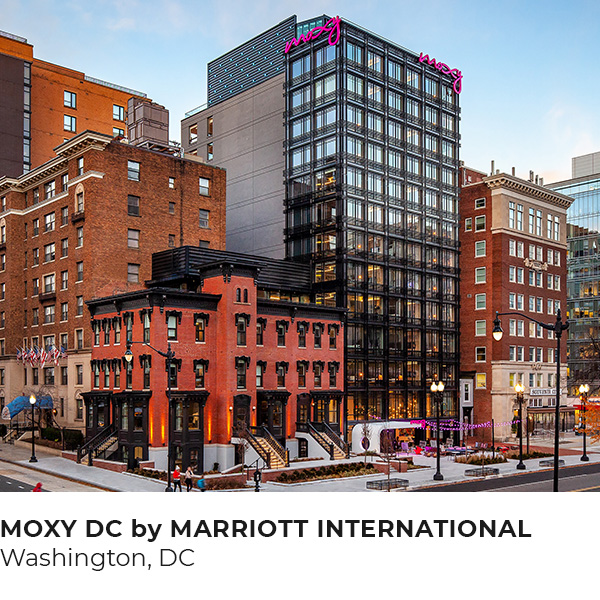October 16, 2019
Major hotel chains such as Marriott and Hilton are expanding the footprint of the microhotel segment in big cities around the world with new brands. They’re following smaller operators, such as CitizenM, Yotel, Mama Shelter and Pod Hotels, that have played in the tiny-room sandbox for more than a decade and continue to grow. As they do, they are trying to lure customers who are sensitive to price, hungry for experiences and comfortable with tight spaces.
With rooms generally smaller (sometimes much smaller) than 200 square feet, today’s microhotels are emphasizing in-demand locations and buzzy common areas while offering rooms that are described as “cozy,” “highly efficient,” “functional” and “the most fun you’ll have in 14 sq m” (or about 150 square feet).
“The whole concept of the microhotel is trying to get the guest out of the room and into the public space,” says Jing Yang, an assistant professor at New York University’s Tisch Center of Hospitality, part of the School of Professional Studies.
[Marriott’s new millennial-aimed hotel room: Stylish, cheap and smaller than 200 square feet]
Travelers have long had the option to choose minuscule accommodations, experts point out, from bunks in European hostels to capsule-size sleeping quarters in Japan. But those were typically spartan and utilitarian, with a priority on price. The new versions have loftier aspirations.
“Where ‘micro’ was associated with cheap and small, today, this micro is more higher-quality experiential and kind of cool,” says Jim Anhut, director of the hospitality business real estate minor at Michigan State University.
As a former hotel executive, Anhut helped launch several brands. And now he’s a partner in a small venture capital firm that has invested in small-room hostel concepts. He says many modern travelers don’t want to spend the money on empty space in a room.
“Why do I need 300-plus square feet? I’m plenty happy with 175 square feet,” he says. “It allows the hotelier and brand and developer to put a lot more investment in the quality of the fixtures, the floor, the bedding. They’ve accomplished the same thing in 120 square feet less.”
Marriott’s Moxy has been on the leading edge of the recent growth. After launching in 2014, Moxy has 46 properties around the globe with 104 more in the pipeline. The brand tries to keep its rooms about 183 square feet, occasionally a bit smaller, and typically opens in dense urban downtown markets where it can (but doesn’t necessarily always) offer rooms at a lower price point than competitors.
“The approach certainly was to find a way to create and optimize the design of a cozy, small-but-smart guest room, but really infuse it with a design that is filled with high-end finishes and allows you to personalize it,” says Toni Stoeckl, global brand leader for Moxy Hotels.
Much of the furniture, like a folding table, chair and luggage rack, hangs on the wall. Research showed guests didn’t want to skimp on restrooms, so the brand prioritized “an amazing shower experience.”
“The efficiency of how they utilize the space is actually pretty optimal,” says Yang, the NYU professor. “It’s not like they’re sacrificing a lot of space, per se, but with the engineering and interior design, they’re able to pack a lot, even though usually the square footage of microhotels is half the size of a traditional hotel.”
At Moxy, the front desk is no more; guests check in at the bar and get a free welcome drink.
“In many ways, this guest wants to mingle with other guests and locals, so the focus on the public space has been really huge,” Stoeckl says.
[D.C.’s first Pod hotel — seen through millennial and Gen X eyes]
That will also be the case for the new Hilton brand, Motto, which was announced a year ago. Rooms will start at about 165 square feet and be priced affordably, though rates haven’t been set.
“Design the room for the guests. When you look at the lobby space, design it for the locals.”
Tripp McLaughlin, global head for Motto
“What we’ve said is, we’ll design the room for the guests,” says Tripp McLaughlin, global head for Motto. “When you look at the lobby space, design it for the locals.”
The company is telling owners the public area should have a local designer and local restaurateur, mixologist and barista to create what the space should look like so each is tied to its location.
The first property is expected to open around the end of next year or early 2021, and sites in several U.S. cities, as well as Copenhagen, Milan and Mexico City, are expected to follow. More than 10 deals are approved or in the works so far, McLaughlin said.
Like at other microhotels, a location in crowded urban cores where occupancy rates are high will be key.
“We can fit three Motto rooms in the same footprint as two Hampton rooms,” McLaughlin says. “It’s a little bit tiny. But what we’ve heard from owners is, number one, they like it, because they couldn’t make an 80-room Hampton work in the city center of D.C. because it’s too expensive. But now if you’re looking at a 110-room Motto, it becomes more profitable for them.”
The company wants Motto to cater to business and leisure travelers and plans a “casual, comfortable residential feel.” To compete with alternative options, such as Airbnb, the hotels will include flexible spaces with fold-down wall beds that can adjoin standard rooms to give large groups plenty of room to spread out while staying connected.
For Mike LaRosa, who writes about co-working and travel on his Coworkaholic blog, microhotels fit the bill. He is also co-founder of a real estate development and management company that consults with hospitality companies, including Marriott, and did some work on the Moxy concept.
LaRosa has stayed in Moxy hotels and no-brand capsule hotels in Japan, worked in the lobby of a CitizenM and recently napped between flights at a Yotelair “cabin” at London Gatwick Airport, which has “capsule rooms that are even smaller than you would imagine.”
At 34, he’s squarely in the millennial demographic that microhotels want to appeal to. He’s looking for value. And he doesn’t need all that much.
“We’re not hanging out in our rooms,” he says. “If you have space that’s designed to be productive and to connect with people, then that’s what we’re looking for.”



